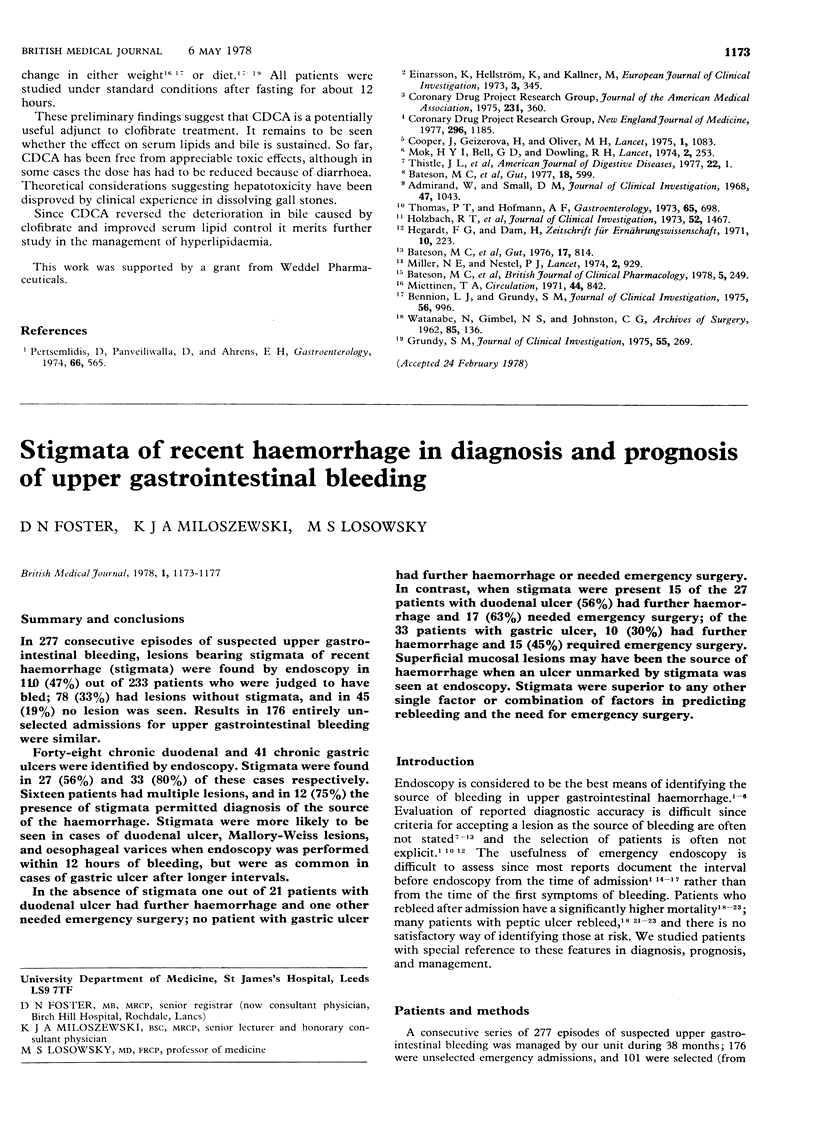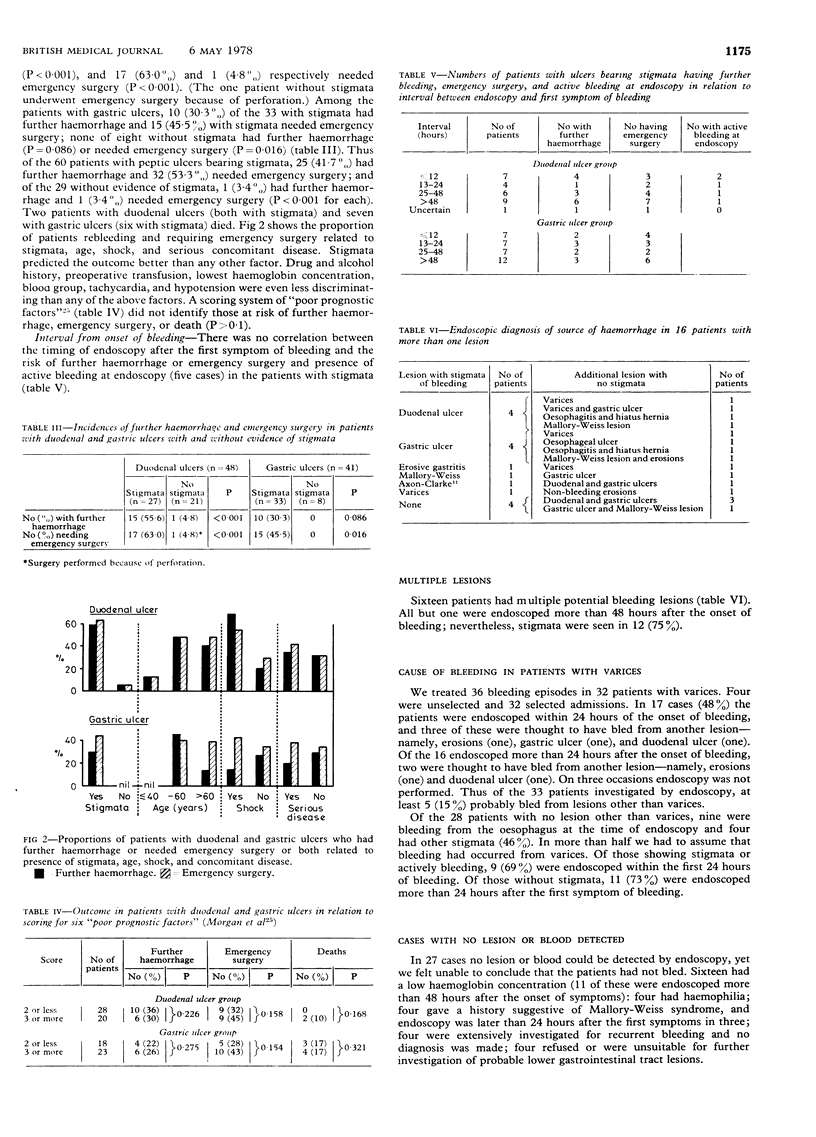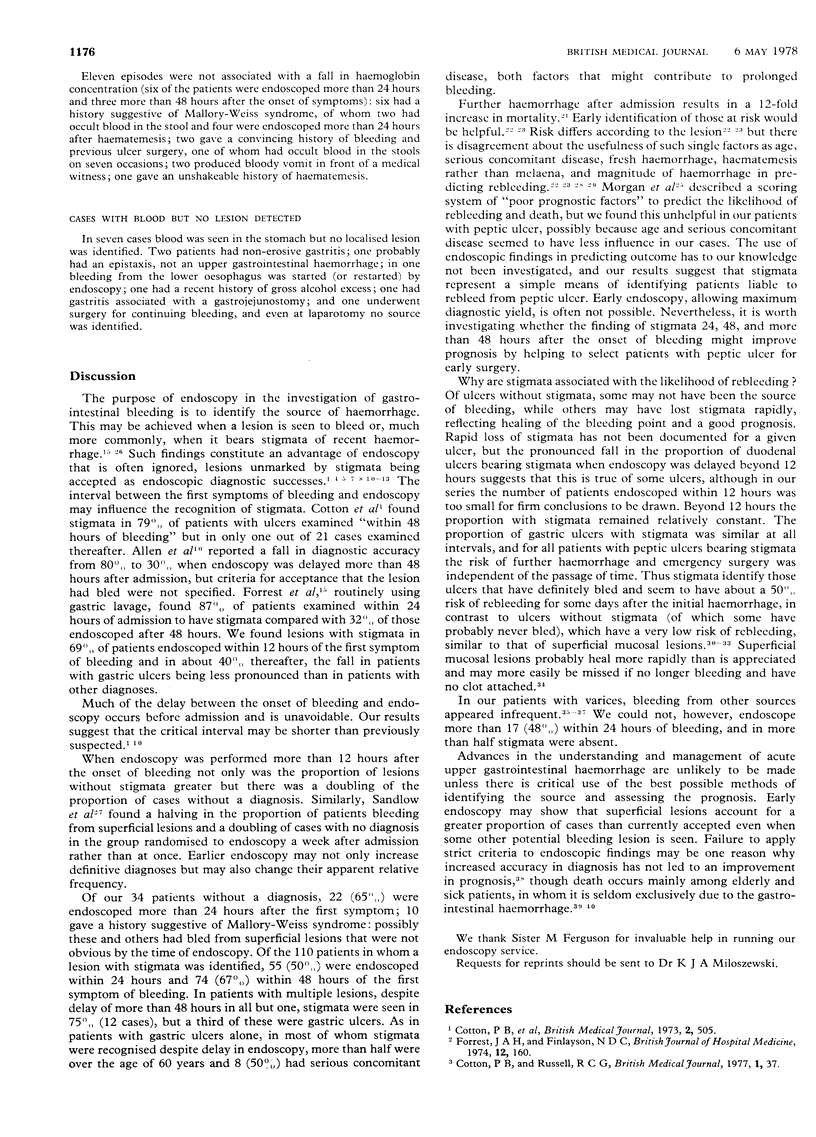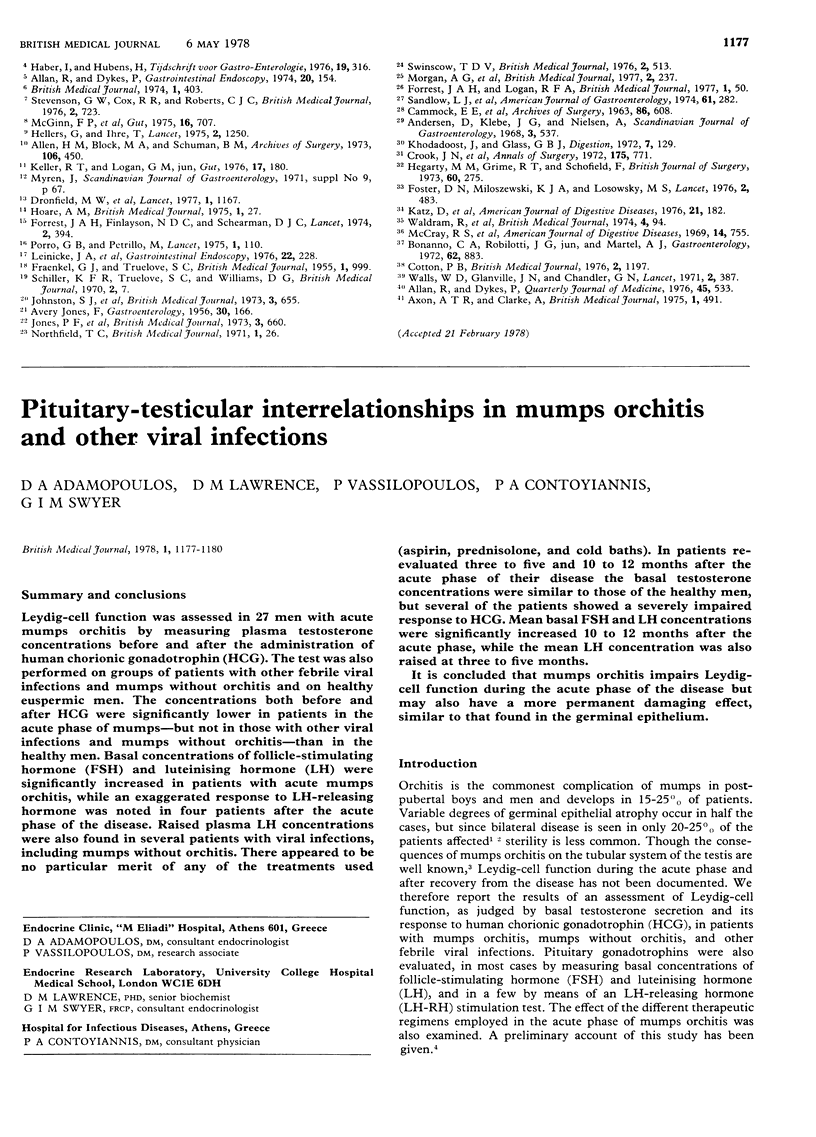Abstract
In 277 consecutive episodes of suspected upper gastrointestinal bleeding, lesions bearing stigmata of recent haemorrhage (stigmata) were found by endoscopy in 110 (47%) out of 233 patients who were judged to have bled; 78 (33%) had lesions without stigmata, and in 45 (19%) no lesion was seen. Results in 176 entirely unselected admissions for upper gastrointestinal bleeding were similar.
Forty-eight chronic duodenal and 41 chronic gastric ulcers were identified by endoscopy. Stigmata were found in 27 (56%) and 33 (80%) of these cases respectively. Sixteen patients had multiple lesions, and in 12 (75%) the presence of stigmata permitted diagnosis of the source of the haemorrhage. Stigmata were more likely to be seen in cases of duodenal ulcer, Mallory-Weiss lesions, and oesophageal varices when endoscopy was performed within 12 hours of bleeding, but were as common in cases of gastric ulcer after longer intervals.
In the absence of stigmata one out of 21 patients with duodenal ulcer had further haemorrhage and one other needed emergency surgery; no patient with gastric ulcer had further haemorrhage or needed emergency surgery. In contrast, when stigmata were present 15 of the 27 patients with duodenal ulcer (56%) had further haemorrhage and 17 (63%) needed emergency surgery; of the 33 patients with gastric ulcer, 10 (30%) had further haemorrhage and 15 (45%) required emergency surgery. Superficial mucosal lesions may have been the source of haemorrhage when an ulcer unmarked by stigmata was seen at endoscopy. Stigmata were superior to any other single factor or combination of factors in predicting rebleeding and the need for emergency surgery.
Full text
PDF




Selected References
These references are in PubMed. This may not be the complete list of references from this article.
- Allan R., Dykes P. A comparison of routine and selective endoscopy in the management of acute gastrointestinal hemorrhage. Gastrointest Endosc. 1974 May;20(4):154–155. doi: 10.1016/s0016-5107(74)73916-5. [DOI] [PubMed] [Google Scholar]
- Allan R., Dykes P. A study of the factors influencing mortality rates from gastrointestinal haemorrhage. Q J Med. 1976 Oct;45(180):533–550. [PubMed] [Google Scholar]
- Allen H. M., Block M. A., Schuman B. M. Gastroduodenal endoscopy. Management of acute upper gastrointestinal hemorrhage. Arch Surg. 1973 Apr;106(4):450–455. doi: 10.1001/archsurg.1973.01350160068011. [DOI] [PubMed] [Google Scholar]
- Andersen D., Klebe J. G., Nielsen A. Evaluation of the prognostic significance of various factors in massive ulcer haemorrhage. Scand J Gastroenterol. 1968;3(5):537–544. doi: 10.3109/00365526809179914. [DOI] [PubMed] [Google Scholar]
- Axon A. T., Clarke A. Haematemesis: a new syndrome? Br Med J. 1975 Mar 1;1(5956):491–492. doi: 10.1136/bmj.1.5956.491. [DOI] [PMC free article] [PubMed] [Google Scholar]
- CAMMOCK E. E., HALLETT W. Y., NYHUS L. M., HARKINS H. N. Diagnosis and therapy in gastrointestinal hemorrhage. A study of 410 patients. Arch Surg. 1963 Apr;86:608–614. doi: 10.1001/archsurg.1963.01310100092014. [DOI] [PubMed] [Google Scholar]
- Cotton P. B. Comparative diagnostic accuracy of barium meal and endoscopy. Br Med J. 1976 Nov 13;2(6045):1197–1198. doi: 10.1136/bmj.2.6045.1197-c. [DOI] [PMC free article] [PubMed] [Google Scholar]
- Cotton P. B., Rosenberg M. T., Waldram R. P., Axon A. T. Early endoscopy of oesophagus, stomach, and duodenal bulb in patients with haematemesis and melaena. Br Med J. 1973 Jun 2;2(5865):505–509. doi: 10.1136/bmj.2.5865.505. [DOI] [PMC free article] [PubMed] [Google Scholar]
- Crook J. N., Gray L. W., Jr, Nance F. C., Cohn I., Jr Upper gastrointestinal bleeding. Ann Surg. 1972 May;175(5):771–782. doi: 10.1097/00000658-197205000-00017. [DOI] [PMC free article] [PubMed] [Google Scholar]
- FRAENKEL G. J., TRUELOVE S. C. Haematemesis, with special reference to peptic ulcer. Br Med J. 1955 Apr 23;1(4920):999–1002. doi: 10.1136/bmj.1.4920.999. [DOI] [PMC free article] [PubMed] [Google Scholar]
- Forrest J. A., Finlayson N. D., Shearman D. J. Endoscopy in gastrointestinal bleeding. Lancet. 1974 Aug 17;2(7877):394–397. doi: 10.1016/s0140-6736(74)91770-x. [DOI] [PubMed] [Google Scholar]
- Forrest J. A., Logan R. F. Comparative diagnostic accuracy of barium meal and endoscopy. Br Med J. 1977 Jan 1;1(6052):50–50. doi: 10.1136/bmj.1.6052.50-a. [DOI] [PMC free article] [PubMed] [Google Scholar]
- Foster D. N., Miloszewski K., Losowsky M. S. Diagnosis of Mallory-Weiss lesions. A common cause of upper gastrointestinal bleeding. Lancet. 1976 Sep 4;1(7984):483–484. doi: 10.1016/s0140-6736(76)90785-6. [DOI] [PubMed] [Google Scholar]
- Haber I., Hubens H. Endoscopy in the diagnosis of upper gastrointestinal bleeding. Tijdschr Gastroenterol. 1976;29(5):316–324. [PubMed] [Google Scholar]
- Hegarty M. M., Grime R. T., Schofield P. F. The management of upper gastro-intestinal tract haemorrhage. Br J Surg. 1973 Apr;60(4):275–279. doi: 10.1002/bjs.1800600406. [DOI] [PubMed] [Google Scholar]
- Hellers G., Ihre T. Impact of change to early diagnosis and surgery in major upper gastrointestinal bleeding. Lancet. 1975 Dec 20;2(7947):1250–1251. doi: 10.1016/s0140-6736(75)92085-1. [DOI] [PubMed] [Google Scholar]
- Hoare A. M. Comparative study between endoscopy and radiology in acute upper gastrointestinal haemorrhage. Br Med J. 1975 Jan 4;1(5948):27–30. doi: 10.1136/bmj.1.5948.27. [DOI] [PMC free article] [PubMed] [Google Scholar]
- Keller R. T., Logan G. M., Jr Comparison of emergent endoscopy and upper gastrointestinal series radiography in acute upper gastrointestinal haemorrhage. Gut. 1976 Mar;17(3):180–184. doi: 10.1136/gut.17.3.180. [DOI] [PMC free article] [PubMed] [Google Scholar]
- Khodadoost J., Glass G. B. Erosive gastritis and acute gastroduodenal ulcerations as source of upper gastrointestinal bleeding in liver cirrhosis. Digestion. 1972;7(3):129–138. doi: 10.1159/000197267. [DOI] [PubMed] [Google Scholar]
- Porro G. B., Petrillo M. Letter: Emergency endoscopy in gastrointestinal bleeding. Lancet. 1975 Jan 11;1(7898):110–110. doi: 10.1016/s0140-6736(75)91124-1. [DOI] [PubMed] [Google Scholar]
- Sandlow L. J., Becker G. H., Spellberg M. A., Allen H. A., Berg M., Berry L. H., Newman E. A. A prospective randomized study of the management of upper gastrointestinal hemorrhage. Am J Gastroenterol. 1974 Apr;61(4):282–289. [PubMed] [Google Scholar]
- Schiller K. F., Truelove S. C., Williams D. G. Haematemesis and melaena, with special reference to factors influencing the outcome. Br Med J. 1970 Apr 4;2(5700):7–14. doi: 10.1136/bmj.2.5700.7. [DOI] [PMC free article] [PubMed] [Google Scholar]
- Stevenson G. W., Cox R. R., Roberts C. J. Prospective comparison of double-contrast barium meal examination and fibreoptic endoscopy in acute upper gastrointestinal haemorrhage. Br Med J. 1976 Sep 25;2(6038):723–724. doi: 10.1136/bmj.2.6038.723. [DOI] [PMC free article] [PubMed] [Google Scholar]
- Swinscow T. D. Statistics at square one. XV--The chi-squared tests (continued). Br Med J. 1976 Aug 28;2(6034):513–514. doi: 10.1136/bmj.2.6034.513. [DOI] [PMC free article] [PubMed] [Google Scholar]
- Waldram R., Davis M., Nunnerley H., Williams R. Emergency endoscopy after gastrointestinal haemorrhage in 50 patients with portal hypertension. Br Med J. 1974 Oct 12;4(5936):94–96. doi: 10.1136/bmj.4.5936.94. [DOI] [PMC free article] [PubMed] [Google Scholar]
- Walls W. D., Glanville J. N., Chandler G. N. Early investigation of haematemesis and melaena. Lancet. 1971 Aug 21;2(7721):387–390. doi: 10.1016/s0140-6736(71)90110-3. [DOI] [PubMed] [Google Scholar]


